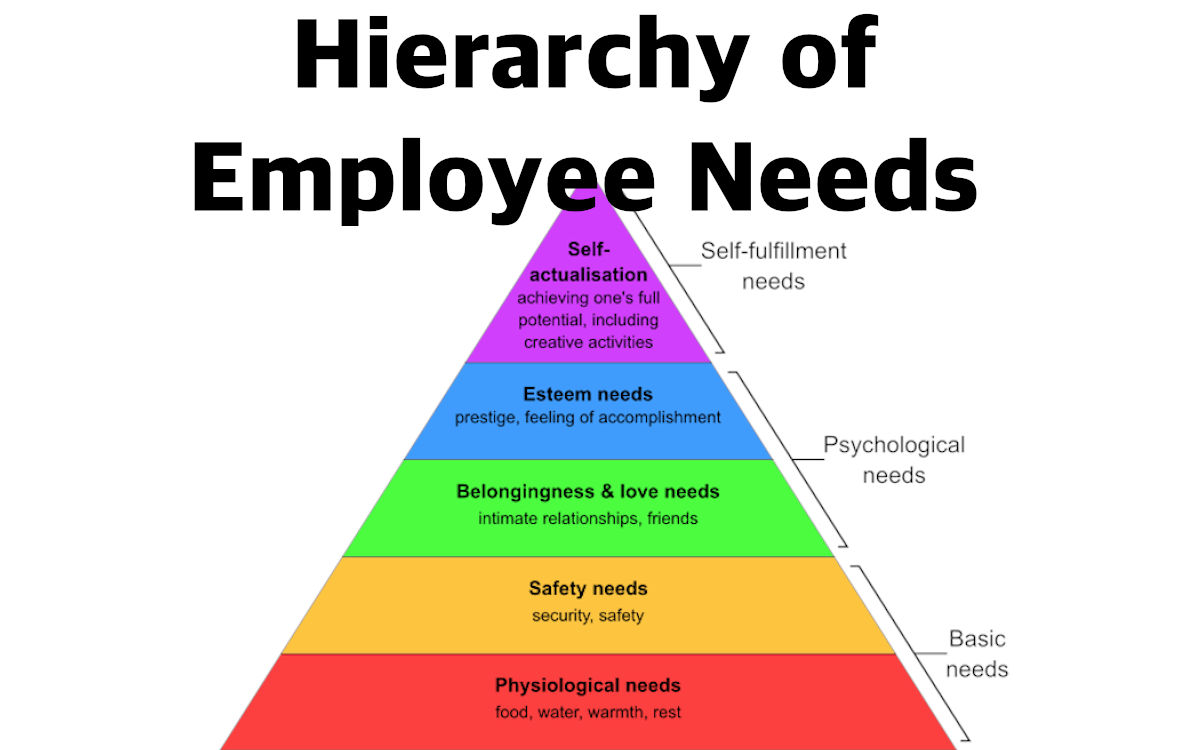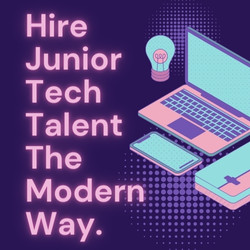This blog article conforms to our Editorial Policy and contains links to paid referral affiliates.
In my article “What Is The Role of Human Resources?” I wrote that a good leader needs to learn about the needs of employees. Employees are people with needs. Employees get jobs and trade their time for money because they must pay for their needs. An employee who does not get a job to help the organizations they work for is called volunteering.
A good way to help your organization grow and to create loyal employees is by applying Maslow’s Hierarchy of Needs to your employee’s needs.
to your employee’s needs.
- You need to address basic needs like paying a living wage for your area, paying higher than industry-standard wages, and automatically increasing wages with the cost of living each year.
- You need to address psychological needs by having good benefits, a good work environment, merit pay increases, and regular recognition of good work.
- You need to address self-fulfillment needs by offering internal promotions for career advancement, regular training, and, least importantly, one-time bonuses or perks.
The rest of this article will examine individual needs more closely. To better understand Maslow’s Hierarchy of Needs, click here to see the top books (Paid Link) on Amazon.
Basic Needs
Paying a Living Wage – Physiological
Do not confuse Living Wage with Minimum Wage. If you pay minimum wage, you are paying just enough to prevent yourself from getting sued and may be sent to jail. Employers that pay minimum wage are evil or greedy people that should not be in business. If you can only afford to pay the minimum, then your organization is fundamentally flawed and needs to be reorganized.
Get creative and make Living Wages happen! The Living Wage in each area is different so you need to take some time to research this. If you can’t find the exact wage for your area then take the three closest or similar Living Wages you can find, add them up, divide them by how many you found in this case three, and then round up to the next 50 cents or dollar.
You should never pay less than the Living Wage. Doing this will solve a very large portion of your organizational issues related to employees and even low sales. Paying well helps to eliminate an employee’s personal issues.
Now employees can afford childcare, so they don’t call in sick as much. Now employees can afford reliable transportation, so they will not be as late as much. Now employees don’t have to have a second job, or they can quit their third job.
All these types of employee personal issues divide their attention while at work. Instead of worrying about how they will feed their children tonight, they can concentrate on making the sale or helping their customers. This can lead to higher profits!
For more on living wage see our article Why Should You Pay a Living Wage to Your Employees?
Paying Higher Than Industry Standard – Physiological/Safety
If you pay higher than the industry standard for your industry some amazing things start to happen. Leading the way with competitive wages in your industry will start creating real safety for your employees. This is very attractive, so more people will want to work for you. You will even begin to attract the top performers in your industry!
At the very least you will not lose your top performers and your employee turnover will get better. Low performers will naturally leave or step up as they are increasingly surrounded by harder workers that perform at a higher level. Again, a pay increase could lead your organization to higher profits!
For more information read our article Top 5 Reasons to Pay Higher Than Industry Standard.
Cost of Living Pay Increases – Safety
The best way for an employee to get a raise is to get a new job so they can negotiate a higher wage at the new organization. Naturally, as an employer you don’t want this to happen, you want top performers to stay with you long-term. The employee is looking for long-term security and a good way to give them this is the regular guaranteed cost of living pay increases.
At the very base level, the employer would not keep a bad employee. So, one way of showing that an employee is not bad is by giving a pay increase each year. They may not be a rock star employee that you may not want to give a merit pay increase. Although, they are part of your average employees that make up the backbone of your organization. Any organization can’t afford to lose many backbone employees so they should be given long-term security.
You can do this one of two ways:
- At the start of each year give everyone a pay increase based on last year’s inflation rate. Sometimes this can fluctuate drastically from 0% to 10% and maybe cause some accounting or cashflow issues.
- Again at the start of each year take the last three- or five-years inflation rate and calculate the average. Always try to round up to the next half or full percent to be fairer after high inflation years. This average rate will make it easier for your accounting and cash flow shock.
For more information read our article Top Reasons to Have Cost of Living Pay Increases.
Psychological Needs
Good Benefits – Belongingness & Love
Good benefits show that an organization cares about their employees. If you have no benefits, moving to any level of benefits is better. Then a move to good benefits with time will work also. If your competitors have the same pay and better benefits, you may lose out on some top performers. However, current employees will be less likely to leave since you started offering benefits or improved your benefits.
Benefits directly help your employees to be healthy, reduce stress, and miss less work. Benefits also directly help your employees’ families! Happy, healthy families are what makes the world work.
For more information, read our article “The Case for Good Benefits.”
Bereavement leave is an important legislation in most areas and can be upgraded to a thoughtful benefit that does not cost much but can create a lot of employee loyalty. Read our article “Rethinking Bereavement Leave. “
“
Good Work Environment – Belongingness & Love
Toxic work environments can bring organizations down quickly! By addressing the basic needs in the previous section and the benefits above, many issues may already be solved. The rest of the issues likely stem from bad managers and bad policies.
For bad managers, you need to train them better at managing people. If a manager continues to have issues with their team after additional training, then it may be time for them to go. Promoting from within is always a good policy if you have a good management training program. Managers fail because they don’t know how to manage people.
For bad policies, you need to get your whole organization involved. Have the employees give input, fix, or draft new policies. This will create buy-in for the policies. In general, less is more when it comes to many employee or HR-related policies.
For more information, read our article What is a Good Work Environment?
Mental health may be a factor when dealing with improving the work environment, so read this article, “Addressing Mental Health in The Workplace as an Owner or Manager.”
Merit Pay Increases – Esteem
Merit pay increases are what drive top performers or rock star employees. Top performers are experts in what they do, and you should reward them for it. Many top performers want to get promoted to a manager role not because they want to manage but because they want higher pay.
This is how we get bad managers and low-performing teams. The best person on the team is no longer doing the work so performance is down. Then the new untrained manager who is an expert in the work tries to increase performance in all the wrong ways.
Giving merit pay increases will keep top performers right where the organization needs them. You may even end up paying a top performer more than their manager. This is okay if everyone understands the value of the work being done.
For more information read our article The Importance of Merit Pay Increases.
Recognition of Good Work – Esteem
Employers must continually give recognition for good work. Employees must always feel they are contributing to the success of the organization. Some sort of monthly or quarterly awards and recognition program should be implemented. Remember that some people do not like recognition at public events, so always ask employees how they would like to be recognized.
Employers sometimes fear giving recognition because they think the employee will ask for or demand a raise. This would not be as big an issue if they’re already paid well, as discussed in the Basic Needs section above.
For more information read our article The Importance of Recognizing Good Work.
Self-Fulfillment Needs
High-Potential Employees
One major type of employee who needs your attention with self-fulfillment needs is high-potential employees. These are the employees who can become your next rock stars! Read this article for more information on “Supporting High-Potential Employees.”
Internal Promotions – Self-Actualization
Internal promotions are an amazing way to create loyalty and trust with your current employees! Career advancement is a major concern for many employees. Bringing in a new person from the outside can create problems for employee mindsets.
Deciding who gets the promotion can be the hard part but not if you have the proper training and plan in place.
For more information, read our article Internal Promotions Are the Gold Standard.
Regular Training – Self-Actualization
Regular training opportunities are important for all levels of employees. At the base, you need to keep skills updated for current roles due to normal technological and societal changes.
Lateral moves in the organization are just as important as promotions. As employees learn more roles, they become more valuable to the organization. Consider cross-training for any interested employee. As an employee learns more skills you should consider merit pay increases after the skill is mastered.
Management training is vital for internal promotions. When an employee indicates that they want to advance to management, you should have multi-part training, job shadowing, and acting or cover-off program in place. It may take an employee a year or more to be qualified to be a manager.
For more information read our article Regular Training for a World-Class Team.
One-Time Bonuses or Perks – Self-Actualization
The least important on this list is giving one-time bonuses or perks. So many organizations think a perk will increase morale or improve the work environment. This is wrong! A pizza party will not take away stress, will not pay for daycare, will not pay the rent, will not buy a bus pass, will not pay off a credit card, and will not help build an emergency fund. A pizza party is a slap in employees’ faces when times are hard.
If you really want to have a pizza party then you need to read my blog article “The Art of the Pizza Party.”
If you want to give out bonuses and perks, address all the other sections above in this article. Then, formalize them and let everyone know what the process is. Ultimately, bonuses and perks should only be triggered and given when conditions are met and when times are great.
An example is: When the organization makes $X each employee that achieves Y gets a bonus of Z.
For more information, read our article Know When to Implement One-Time Bonuses or Perks.
What Should You Do Now?
If you want to use this information you can implement each “need” from the top of the article. As you implement each section or need the next one, it will be easier to do. Your employees will appreciate the changes you make.
However, it may take some time for attitudes to change if you have some serious employee and work environment issues. These changes may take six to twelve months or more to produce positive benefits. Be patient! Good luck!
For human resources support in Canada, click here to book a free HR needs assessment now. If you’re on a budget, consider joining my Patreon to ask unlimited HR questions. If you need HR advice sooner, book a consultation via Fiverr here.
HR questions. If you need HR advice sooner, book a consultation via Fiverr here.




